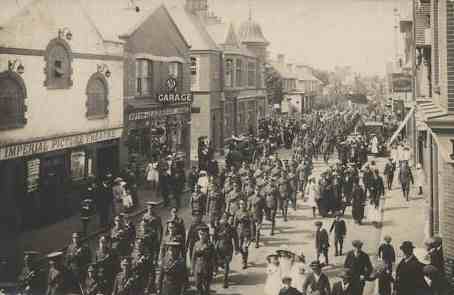
War
First World War Regiments

The 11th, 12th and 13th battalions of the Royal Sussex Regiment embarked for France in March 1916, and first saw
battle at Richebourg in French Flanders. On 30th June 1916 they were involved in an attack on the German lines,
occupying the German first and second line trenches for a short while, but were forced to withdraw. The action, with
no overall gain, ended with many casualties who now lie in a nearby military cemetery, including four Crawley men,
two of whom were brothers.
Crawley Night Landing Ground
A home defence Night Landing Ground was designated adjacent to Bewbush Manor for 78 (Home Defence) Squadron
of the Royal Flying Corps. It was used for a few weeks during Janaury and February 1917, and was abandoned perhaps because it was liable to
flooding.
Cross & Cockade International, Summer 2011
Forgotten Aerodromes of World War I. Martyn Chorlton (Crecy Publishing, 2014)
Forgotten Aerodromes of World War I. Martyn Chorlton (Crecy Publishing, 2014)
Canadian Soldiers
Canadian volunteers arrived after the declaration of war, and were billeted in large houses around the county. Huts
were built to accommodate Canadian soldiers in Tilgate Forest.
German Aircraft, 1940
A Dornier 17 was shot by aircraft and anti-aircraft gunfire at Gatwick, and crashed at West Houthly at 4.10 p.m.
on 10th September 1940.
A Messerschmitt ME110 was shot down by fighters and crashed at Gatwick Airport at 10 a.m. on 27th September 1940.
Following damage from fighter and anti-aircraft fire a Junkers 88 made a force-landing on Gatwick Racecourse on 30th
September 1940. It was put on display to raise money for Wings for Victory week.
A Junkers 88 crashed and exploded at Toovies Farm at 11.20 a.m. on 8th November 1940. The crew were killed and a
farmhand was badly injured.
"The Giant German Bomber"- a Heinkel 111 was put on display in Springfield Road to raise money for Horsham and District
Spitfire Fund. Admission was a minimum of 6d for adults and 3d for children.
Air Raid, 4th February 1943
Early in the morning of 4th February 1943 a German plane was seen circling the Crawley and East Grinstead area.
After 20 minutes it machine-gunned West Green and dropped bombs on Spencer's Road, wrecking the Church of England
Infants School, the Scout's Headquarters and the Salvation Army Hall, as well as damaging several houses. The
aircraft then bombed the High Street, hitting the Post Office and Willett's printers, and finally the Baptist Chapel
and a house in Station Road, killing two women. Eighteen others were injured, some seriously.
V1 Attacks, 1944
Between 2pm and 4pm on 10th July a V1 flying bomb destroyed fifteen houses, killing seven and seriously injuring
44 others when it fell at the junction of Oak Road and West Street, West Green on 10th July 1944.
Late that night or in the early hours of the following morning, a V1 landed in Malthouse Road allotments but did
not explode. Residents were evacuated and billeted in West Green School whilst it was dealt with.
A V1 fell close to Ifield cricket ground badly damaging cottages and the school, which was later demolished, on
the south side of the green.
Barracks to Bunkers. Peter Longstaff-Tyrrell (Sutton Publishing, 2002)
VE Day, 1945
Crawley and Ifield War Memorial
The War Memorial, erected in the 1920s as a reminder of Crawley's dead in the First War, stands in front of St.
John's Church. In 1921, the local community raised funds to buy land for the
Memorial Gardens, for use as a public recreation ground and
in memory of those who lost their lives during the Great War.
Crawley Parish Council made plans in May 1947 for a memorial naming those who had
died for their country on panels at the entrance to the Memorial Gardens. The cost of £140 was to be raised from
donations, as no public funds were available.